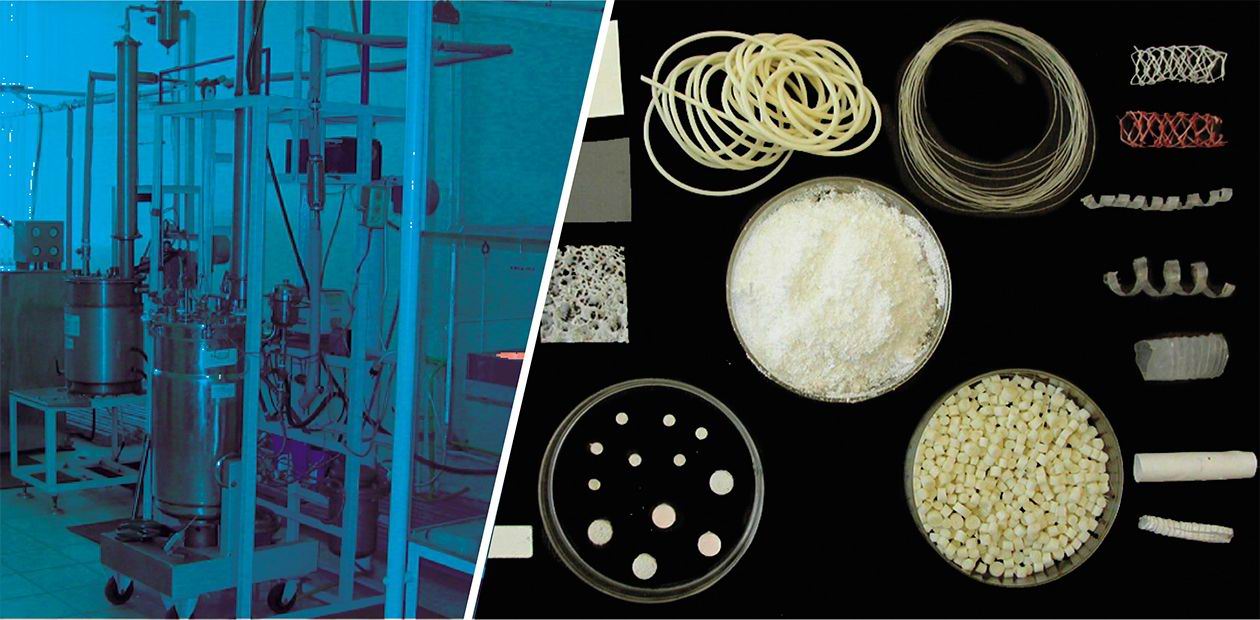Promising Plastic Material for Medicine
The first Russian certified pilot facility for production of biodegradable polyester-bioplastotan-has been functioning in Krasnoyarsk. It has been designed and put into operation at the Institute of Biophysics SB RAS. A family of experimental items based on the novel material and intended for medicine have been designed and tested. It has been proven that bioplastotan can be effectively used in surgery as suture material, anti-adhesion barriers, and stents for reconstruction of bile ducts
Development of new, environmentally friendly materials, which can be involved in the biospheric cycling, is in line with the conception of sustainable industrial development. Synthetic nondegradable polymers have revolutionized our way of life. Recent years have seen an increasing interest in biopolymers, i.e. polymers of biological origin. The main goal of studies in this field is to find and examine novel materials and to construct biological systems that would synthesize polymers with target properties.
The sphere that has the greatest demand for biopolymers is medicine. Treatment efficiency cannot be improved without high-functionality materials being introduced into practical surgical reconstruction. In case of some severe diseases, a patient’s life can only be saved by transplanting donor organs. However, donor organs may be not available, and the use of artificial prostheses is limited to temporary maintenance of the functions of vital organs. Thus, the approach that is being actively developed now is creation of bio-artificial organs and tissues.
Although in recent years biomaterials science has had great achievements, no materials have yet been designed that would be fully compatible with a living organism. One of the serious factors that limit the use of biodegradable polymers is their quite narrow range. Another limitation is that no one has so far solved the problem of controlling the rate of biopolymer degradation in the living organism (different medical tasks require different degradation rates), on the one hand, and maintaining properties of biopolymers throughout the time of their functioning in the organism, on the other. The discovery of polyhydroxyalkanoates (PHAs)—polyesters of microbiological origin—has become a remarkable event for biotechnology. PHAs are thermoplastic, biodegradable and biocompatible polymers, whose potential uses are very wide and can include surgical reconstruction, cellular and tissue engineering, and transplant surgery.
In Russia biomedical studies of PHAs are performed at the Institute of Biophysics SB RAS. Researchers of the Institute have developed a technology for the synthesis of polymers with various chemical structures and examined their physicochemical and biomedical properties. The first Russian Pilot Production Facility certified as hygienically safe has been constructed and put into operation.
The fabricated polymer items include sutures, flexible films and membranes, microcapsules and microparticles, solid and porous 3D constructions, including ceramic-polymer composites loaded with biologically active substances and cells. Comprehensive preclinical tests have proved the conformity of the items with the requirements to medical materials and objects. PHAs have been shown to be suitable materials for bone tissue repair in maxillofacial surgery, orthopedics and traumatic surgery, as matrixes to be loaded with drugs and used as controlled-release drug delivery systems, as scaffolds for culturing cells, and as a basis for constructing bio-artificial organs. The results have been protected by a number of RF patents; the first Russian monograph on biotechnology and material studies of these polymers has been published; the material and biomedical items based on it have been trademarked as “Bioplastotan”.
In 2008, researchers of the Institute in cooperation with the specialists of the Department of General Surgery at the Krasnoyarsk Medical University were the first to examine the feasibility of using PHAs in abdominal surgery as stents for bile duct reconstruction, material for intestinal sutures and anastomoses. The obtained results provided a basis for clinical trials. A series of surgical operations has been performed using polymer membranes and polymer-reinforced mesh stents in patients subjected to herniotomy and abdominal surgery. It is the first time surgical stenting of bile ducts in patients with pathological bile excretion using biodegradable PHA-based stents has produced a positive result.
Thus, a scientific and practical basis has been prepared for introducing a new promising biomaterial into practical medicine.







